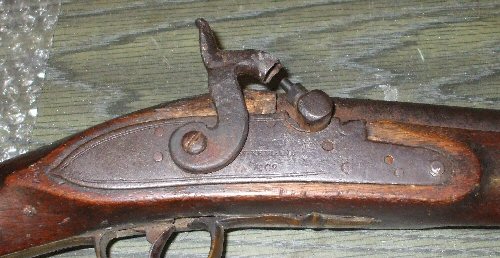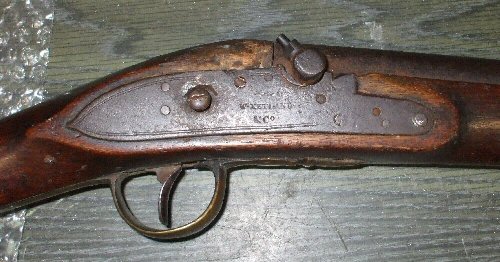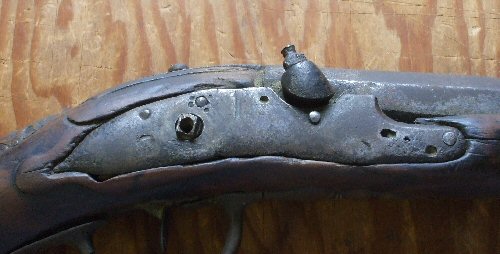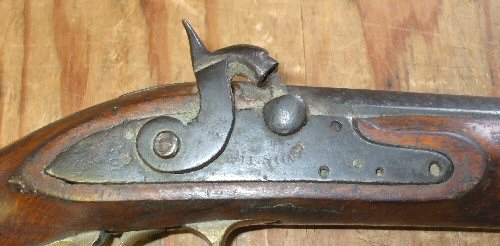Bill S. approached us about converting a couple of 18th century style flintlocks to a caplock ignition system. One is a Ketland Trade pistol and the other is one of our Ship's Carbines. Bill likes to reenact the American Civil War, and of course flintlocks were old fashioned by then. Not fully obsolete, mind you, but certainly not the cutting edge technology that people wanted in the 1860's. There were still plenty of flintlocks around and in use in that era, but at the same time there were a lot of older flintlock muskets and pistols being reworked and updated to use the newer percussion cap ignition system.
This particular project involved one of our Ketland Trade Pistols. I am a big fan of the original Ketland guns, and happen to have a couple of original Ketland muskets here in our reference collection along with an assortment of original caplock-converted guns by other makers.
In the 1830's and later, gunsmiths began modifying existing flintlock weapons by removing the frizzen and frizzen spring, cutting away the pan, changing the cock to a percussion hammer and drilling out the original vent hole to install a drum. A nipple was then installed in the side of the drum to complete the conversion. The old pan area of the lockplate was filed away to more or less meet the contours of the drum. Sometimes the drum was a simple round piece, other times it was filed in the shape of a percussion snail breech.
Sometimes the original flintlock cock was modified to turn it into a percussion hammer by cutting off the top half, where the jaws that hold the flint is, and forge-welding on a hammer head. Less often, but just as functional, you'll run into an original converted flintlock where a slug of steel has been installed in the flintlock's jaws to use as a hammer.
There are several other methods of converting a flintlock to a caplock, but they are a bit more elaborate and involve welding a snail to the side of the barrel to replicate the typical caplocks of the day or building up metal on top of the barrel to install the nipple there. The style where the nipple is installed on top of the barrel is known as the "Belgian method" of converting a flintlock to a caplock. A good example of this style is our 1822 French caplock conversion pistol. These two conversion styles are much more difficult to restore to the original flintlock configuration.
First, here are some images of the study phase. The first few images below are of original guns in our reference collection. These pieces were originally flintlocks spanning from the 1740's through the turn of the 19th century, but all saw a continued service life after being converted to percussion.
| |
|
|
|
|
Here is an original Ketland flintlock musket lock that has been converted to percussion via the drum method. In this case, the flintlock cock has been removed and a new hammer was installed at the time of conversion sometime in the 19th century. The musket dates from around 1800.
|

|
| |
|
|
|
|
Here you can see it with the hammer removed. Note that there is a slight gap between the lockplate and the drum and that you can still see some remnants of the pan from when it was a flintlock. The frizzen and spring holes have been filled with screw that were cut off, but you can still clearly see where they were located.
|

|
| |
|
|
|
|
This one is an early Germanic flintlock dragoon pistol that has been converted to percussion. It is missing it's hammer. Notice that the drum has been shaped to give it the look of a regular percussion snail breech, more or less. The drum still screws in like a round one would, it is just shaped different. I believe these were made oversized, screwed to the barrel, then filed to shape.
|

|
| |
|
|
|
|
This lock is an original East India Co flintlock made in 1790 by Wilson. It was converted to percussion and done quite nicely as the drum fits the lockplate really well. Even so, note how far out of square the top of the nipple is to the striking surface of the hammer. Today people feel that the striking surfaces being square to each other is really important, but by examining the real old guns, we are learning that it didn't seem all that important to folks in the old days because the nipples and hammers on original guns are rarely square to each other.
|

|
To see the steps in converting Bill's Ketland Trade pistol to a caplock, click here to move on to Page 2





